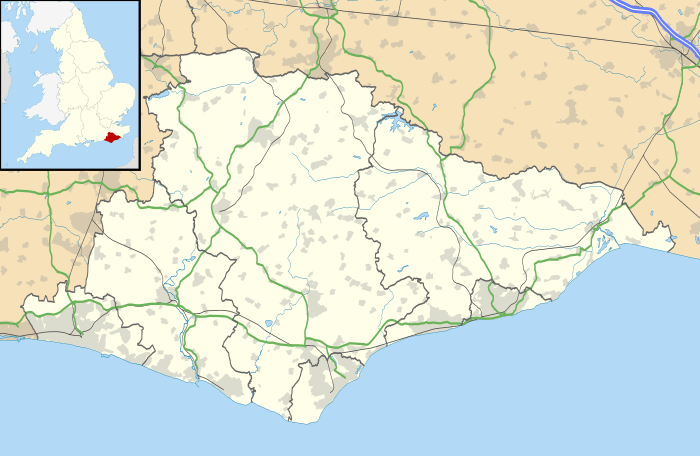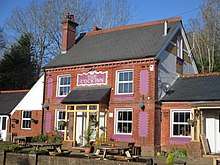Wivelsfield
Wivelsfield village and the larger adjacent village of Wivelsfield Green are the core of the civil parish of Wivelsfield in the Lewes District of East Sussex, England. The villages are 9.3 miles (15.0 km) north of the city of Brighton and Hove.
| Wivelsfield | |
|---|---|
The old village | |
 Wivelsfield Location within East Sussex | |
| Area | 10.8 km2 (4.2 sq mi) [1] |
| Population | 1,980 (Parish-2011)[2] |
| • Density | 181/sq mi (70/km2) |
| OS grid reference | TQ341204 |
| • London | 37 miles (60 km) north |
| Civil parish |
|
| District |
|
| Shire county | |
| Region | |
| Country | England |
| Sovereign state | United Kingdom |
| Post town | HAYWARDS HEATH |
| Postcode district | RH17 |
| Dialling code | 01444 |
| Police | Sussex |
| Fire | East Sussex |
| Ambulance | South East Coast |
| UK Parliament | |
| Website | Wivelsfield Parish Council |
Geography
The village lies in the Low Weald of the Weald and immediately north of the South Downs National Park, which extends to include Ditchling. The soil is clay and mixed sand on top of underlying clay and sandstone.[3] Wivelsfield is one of the larger parishes in the county, though the growth of Burgess Hill to the west reduced the ecclesiastical parish. The parish church is dedicated to St Peter and St John the Baptist. The north of the parish includes several woods and small farms south of Haywards Heath, separated from the nucleus of the village to the south by the Pellingford Brook, a tributary of the River Ouse that flows to Newhaven. Despite the influence of this brook, almost half of the parish drains west to the River Adur, which flows to Shoreham by Sea, reflecting the gently undulating terrain.
Amenities
The current village school was opened in September 2007. The logo, which stands at the front of the school, was designed by the school's pupils. The old school is now used for residential purposes; a nursery rents the Old Church Hall.
The village pub, which for years had been called the Cock Inn, was for a time renamed The Pear Tree. In December 2008, it was announced that the pub would be taken over by the owners of The Fountain in nearby Plumpton Green, who would attempt to revive the pub (once again named The Cock Inn) and the once lively centre of the village.

The village has its own theatre group, the Wivelsfield Little Theatre, which holds productions in the village hall and the church.
History
Wivelsfield is an Anglo-Saxon name meaning the field of a man named "Wifel".[4] There is an 8th-century (c. 765) reference to the village as Wifelesfeld.[3]
In the Domesday Book 1½ hides at Berth here were held by William de Warenne perhaps part of the manor of Hurstpierpoint, West Sussex.
Ote Hall Congregational Chapel was erected in 1778 by the Countess of Huntingdon, who lived at Ote Hall, where a room was converted into a chapel;[3] this was the only manor in the area, with much southern land being in the manors of Plumpton and Ditchling.
In the 18th and early 19th centuries, Wivelsfield was the focus of a small group of local dissenters (Particular Baptists). In 1763, they broke from the larger Ditchling General Baptist community and formed a new meeting under Henry Booker, using a surviving 1780 chapel. The surviving records and memorandum books, as well as Henry Booker's memoirs, provide insights into a small rural religious community of the period.
Historic buildings
There are more than 20 listed buildings in the parish.[5] most highly listed are
- The Church of St Peter and St John the Baptist (see above, Grade II*).[6]
- In the southwest, Great Ote Hall, a grade I listed building.[7] The east wing of the building was built in approximately 1550.[8] The west part of the building dates from 1600 though its history can be traced back to the 13th century.[9]
- In the far west, in the part that merges with the north of Burgess Hill by Wivelsfield Station, is Theobalds, a Grade II* listed building. Its rear wing is 17th century or older and the main door is studded with the date 1627. The Attree family occupied the house from before 1600 to 1823; in 1537 Thomas Attree parted with Ote Hall, which the Attree family had owned since John Attree in 1437.[3][10]
Governance
Wivelsfield is governed at the local level by Wivelsfield Parish Council, which consists of nine councillors who meet twice monthly. The parish council is responsible for local amenities such as the provision of litter bins, bus shelters and allotments. They also provide a voice into district council meetings. The May 2007 election was uncontested.[11]
The next level of government is Lewes District Council. District councils supply services such as refuse collection, planning, leisure amenities and council tax collection. The 2011 elections returned:[12]
| Election | Member | Ward | |
|---|---|---|---|
| 2011 | Sharon Davy | Chailey and Wivelsfield | |
| 2011 | Cyril Sugarman | Chailey and Wivelsfield | |
Wivelsfield also elects a councillor every four years to East Sussex County Council, for the Chailey ward. The ward includes the parishes of Chailey, Ditchling, East Chiltington, Newick, Plumpton, St John Without, Streat and Westmeston. The County Council provides services such as roads and transport, social services, libraries and trading standards.[13]
| Election | Member | Ward | |
|---|---|---|---|
| 2011 | Meg Stroude | Chailey | |
Transport
Bus services are provided by a number of operators including Metrobus,[14] Compass Travel[15] and Seaford and District.[16]
In culture, media and sport
- The English folk singer Martin Carthy produced an LP record entitled 'Sweet Wivelsfield' released in 1974.
- The 1994 Tour de France's fourth stage, from Dover, went via London to Wivelsfield, ending in Brighton.
- Wivelsfield Green is reputed to be the inspiration for the 1960s children's television series Camberwick Green by Gordon Murray, (along with nearby Plumpton as Trumpton and Chailey as Chigley).[17]
Notable people
Eric Roberts, an agent for MI5 and the Secret Intelligence Service, was born in Wivelsfield in 1907. In World War II, Roberts, using the alias Jack King, infiltrated groups of Nazi sympathisers and disrupted their spying activities.[18]
References
| Wikimedia Commons has media related to Wivelsfield. |
- "East Sussex in Figures". East Sussex County Council. Retrieved 26 April 2008.
- "Civil Parish population 2011". Retrieved 11 October 2015.
- Parishes: Wivelsfield, A History of the County of Sussex; Vol. 7: The rape of Lewes (1940), pp. 119–124 Retrieved 16 June 2012 via University of London & History of Parliament Trust website.]
- Ekwall, Eilert (1940) The Concise Dictionary of English Place-names; 2nd ed. Oxford: Clarendon Press; p. 504
- English Heritage The Official List (Listed Buildings) Archived 24 April 2012 at the Wayback Machine
- Historic England. "Details from listed building database (1222972)". National Heritage List for England. Retrieved 16 June 2012. List Entry details of the Church of St Peter and St John the Baptist
- Historic England. "Details from listed building database (1223018)". National Heritage List for England. Retrieved 7 June 2009.
- Historic England. "Details from listed building database (1223018)". National Heritage List for England. Retrieved 16 June 2012.
- "The History of Great Ote Hall". Ote Hall Farm. Retrieved 7 June 2009.
- Historic England. "Details from listed building database (1223095)". National Heritage List for England. Retrieved 16 June 2012. Theobalds
- "Candidates – Town and Parish Council Elections" (PDF). Lewes District Council. 3 May 2007. Retrieved 31 May 2008.
- "Election Results: updated from elections 2004, 2007, 2011". Lewes District Council. Archived from the original on 23 May 2013. Retrieved 16 June 2012.
- "Find your county councillor". Lewes District Council. Retrieved 16 June 2012.
- Route Information - Metrobus
- Bus Timetables - Compass Travel
- Bus timetable and fares - Seaford & District Motor Services
- "In Search of the Real Trumptonshire". Trumptonshire Web. Retrieved 19 April 2009.
- Malnick, Edward (24 October 2014). "MI5 Spy who Cracked Nazi Ring Revealed as Surrey Bank Clerk Eric Roberts". The Telegraph. Retrieved 18 October 2018.